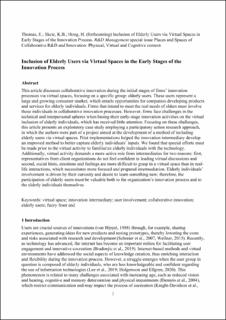| dc.contributor.author | Thomas, Elisa | |
| dc.contributor.author | Skeie, Kristi Bjørnes | |
| dc.contributor.author | Huang, Hong | |
| dc.date.accessioned | 2023-03-21T12:25:19Z | |
| dc.date.available | 2023-03-21T12:25:19Z | |
| dc.date.created | 2022-08-24T19:35:13Z | |
| dc.date.issued | 2022 | |
| dc.identifier.citation | Thomas, E., Skeie, K. B., & Huang, H. (2022). Inclusion of elderly users via virtual spaces in the early stages of the innovation process. R&D Management. | en_US |
| dc.identifier.issn | 0033-6807 | |
| dc.identifier.uri | https://hdl.handle.net/11250/3059533 | |
| dc.description.abstract | This article discusses collaborative innovation during the initial stages of firms' innovation processes via virtual spaces, focusing on a specific group: elderly users. These users represent a large and growing consumer market, which entails opportunities for companies developing products and services for elderly individuals. Firms that intend to meet the real needs of elders must involve those individuals in collaborative innovation processes. However, firms face challenges in the technical and interpersonal spheres when basing their early-stage innovation activities on the virtual inclusion of elderly individuals, which has received little attention. Focusing on these challenges, this article presents an exploratory case study employing a participatory action research approach, in which the authors were part of a project aimed at the development of a method of including elderly users via virtual spaces. Pilot implementations helped the innovation intermediary develop an improved method to better capture elderly individuals' inputs. We found that special efforts must be made prior to the virtual activity to familiarize elderly individuals with the technology. Additionally, virtual activity demands a more active role from intermediaries for two reasons: first, representatives from client organizations do not feel confident in leading virtual discussions and second, social hints, emotions and feelings are more difficult to grasp in a virtual space than in real-life interactions, which necessitates more focused and prepared intermediation. Elderly individuals' involvement is driven by their curiosity and desire to learn something new; therefore, the participation of elderly users must be valuable both to the organization's innovation process and to the elderly individuals themselves. | en_US |
| dc.language.iso | eng | en_US |
| dc.publisher | John Wiley & Sons | en_US |
| dc.rights | Navngivelse 4.0 Internasjonal | * |
| dc.rights.uri | http://creativecommons.org/licenses/by/4.0/deed.no | * |
| dc.title | Inclusion of elderly users via virtual spaces in the early stages of the innovation process | en_US |
| dc.type | Peer reviewed | en_US |
| dc.type | Journal article | en_US |
| dc.description.version | publishedVersion | en_US |
| dc.rights.holder | the authors | en_US |
| dc.subject.nsi | VDP::Samfunnsvitenskap: 200::Økonomi: 210 | en_US |
| dc.source.journal | R&D Management | en_US |
| dc.identifier.doi | 10.1111/radm.12551 | |
| dc.identifier.cristin | 2045792 | |
| cristin.ispublished | true | |
| cristin.fulltext | original | |
| cristin.qualitycode | 1 | |

